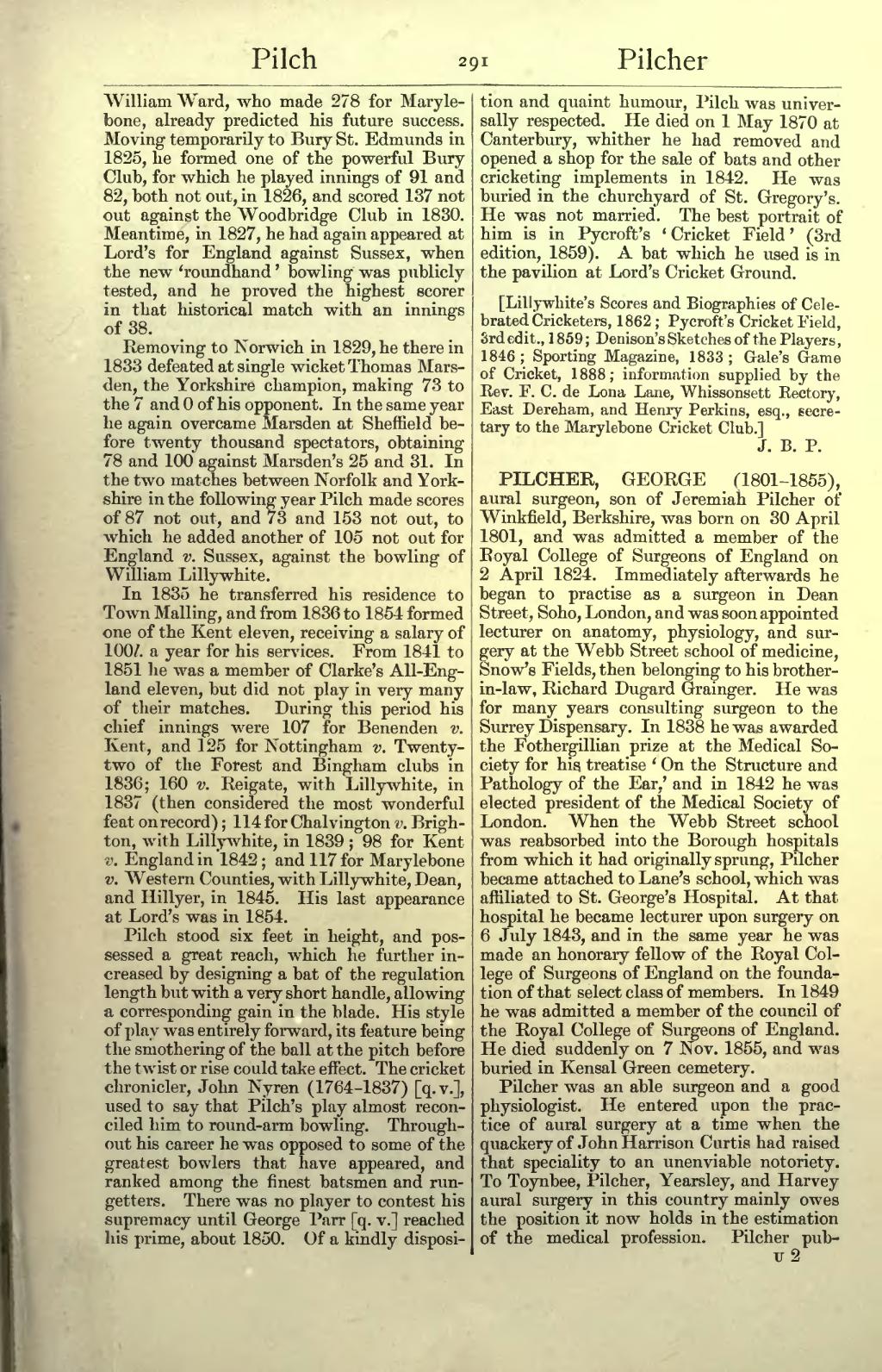William Ward, who made 278 for Marylebone, already predicted his future success. Moving temporarily to Bury St. Edmunds in 1825, he formed one of the powerful Bury Club, for which he played innings of 91 and 82, both not out, in 1826, and scored 137 not out against the Woodbridge Club in 1830. Meantime, in 1827, he had again appeared at Lord's for England against Sussex, when the new ‘roundhand’ bowling was publicly tested, and he proved the highest scorer in that historical match with an innings of 38.
Removing to Norwich in 1829, he there in 1833 defeated at single wicket Thomas Marsden, the Yorkshire champion, making 73 to the 7 and 0 of his opponent. In the same year he again overcame Marsden at Sheffield before twenty thousand spectators, obtaining 78 and 100 against Marsden's 25 and 31. In the two matches between Norfolk and Yorkshire in the following year Pilch made scores of 87 not out, and 73 and 153 not out, to which he added another of 105 not out for England v. Sussex, against the bowling of William Lillywhite.
In 1835 he transferred his residence to Town Malling, and from 1836 to 1854 formed one of the Kent eleven, receiving a salary of 100l. a year for his services. From 1841 to 1851 he was a member of Clarke's All-England eleven, but did not play in very many of their matches. During this period his chief innings were 107 for Benenden v. Kent, and 125 for Nottingham v. Twenty-two of the Forest and Bingham clubs in 1836; 160 v. Reigate, with Lillywhite, in 1837 (then considered the most wonderful feat on record); 114 for Chalvington v. Brighton, with Lillywhite, in 1839; 98 for Kent v. England in 1842; and 117 for Marylebone v. Western Counties, with Lillywhite, Dean, and Hillyer, in 1845. His last appearance at Lord's was in 1854.
Pilch stood six feet in height, and possessed a great reach, which he further increased by designing a bat of the regulation length but with a very short handle, allowing a corresponding gain in the blade. His style of play was entirely forward, its feature being the smothering of the ball at the pitch before the twist or rise could take effect. The cricket chronicler, John Nyren (1764–1837) [q. v.], used to say that Pilch's play almost reconciled him to round-arm bowling. Throughout his career he was opposed to some of the greatest bowlers that have appeared, and ranked among the finest batsmen and run-getters. There was no player to contest his supremacy until George Parr [q. v.] reached his prime, about 1850. Of a kindly disposition and quaint humour, Pilch was universally respected. He died on 1 May 1870 at Canterbury, whither he had removed and opened a shop for the sale of bats and other cricketing implements in 1842. He was buried in the churchyard of St. Gregory's. He was not married. The best portrait of him is in Pycroft's ‘Cricket Field’ (3rd edition, 1859). A bat which he used is in the pavilion at Lord's Cricket Ground.
[Lillywhite's Scores and Biographies of Celebrated Cricketers, 1862; Pycroft's Cricket Field, 3rd edit., 1859; Denison's Sketches of the Players, 1846; Sporting Magazine, 1833; Gale's Game of Cricket, 1888; information supplied by the Rev. F. C. de Lona Lane, Whissonsett Rectory, East Dereham, and Henry Perkins, esq., secretary to the Marylebone Cricket Club.]
PILCHER, GEORGE (1801–1855), aural surgeon, son of Jeremiah Pilcher of Winkfield, Berkshire, was born on 30 April 1801, and was admitted a member of the Royal College of Surgeons of England on 2 April 1824. Immediately afterwards he began to practise as a surgeon in Dean Street, Soho, London, and was soon appointed lecturer on anatomy, physiology, and surgery at the Webb Street school of medicine, Snow's Fields, then belonging to his brother-in-law, Richard Dugard Grainger. He was for many years consulting surgeon to the Surrey Dispensary. In 1838 he was awarded the Fothergillian prize at the Medical Society for his treatise ‘On the Structure and Pathology of the Ear,’ and in 1842 he was elected president of the Medical Society of London. When the Webb Street school was reabsorbed into the Borough hospitals from which it had originally sprung, Pilcher became attached to Lane's school, which was affiliated to St. George's Hospital. At that hospital he became lecturer upon surgery on 6 July 1843, and in the same year he was made an honorary fellow of the Royal College of Surgeons of England on the foundation of that select class of members. In 1849 he was admitted a member of the council of the Royal College of Surgeons of England. He died suddenly on 7 Nov. 1855, and was buried in Kensal Green cemetery.
Pilcher was an able surgeon and a good physiologist. He entered upon the practice of aural surgery at a time when the quackery of John Harrison Curtis had raised that speciality to an unenviable notoriety. To Toynbee, Pilcher, Yearsley, and Harvey aural surgery in this country mainly owes the position it now holds in the estimation of the medical profession. Pilcher pub-
